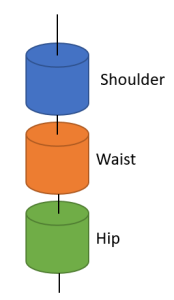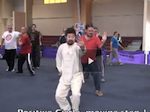Foundations corrections
Positive circle correction (3-count):
- Before I start the first positive circle the middle finger of the front hand must concentrate on a dot. The front middle finger is no higher than the eyebrow. The elbow and palm of the front hand are directed towards the floor. There is a stretch from the front middle finger to the rear foot. The front forearm is stretched and the front shoulder is pinned down (it does not move).
- Keep wrists straight throughout.
- 1st count – Bring in elbow to the ribs while keeping the middle finger stretched out. The hand needs to travel on the line from the “dot” where the middle finger starts to the dantian. When it becomes uncomfortable, bring the elbow in more. Nothing moves while the elbow is being brought in.
- 2nd count – Turning of the waist should not turn the shoulder or the hips. While turning, keep eye on the dot. The knees must not move. Keep the front elbow and hand where it was placed after the first count was completed. The rear shoulder does not move backwards or upwards.
- 3rd count – The front shoulder does not move while the hand comes out. A gap opens up in the front armpit as the front elbow rises up as far as it can without any other body part moving. As the hand goes out a connection needs to be retained between the front shoulder and front kua.
- There is no reset between positive circles. Tightness increases with subsequent positive circles.
Negative circle:
- Keep the middle finger of the front hand pointed at the dot.
- 1st count: The front middle finger and front shoulder are stationary while bringing the front elbow over and around to be directly in front of my middle line.
- 2nd count: The front shoulder does not move as the arm comes down.
Twisting the towel:
- Power is driven from the heel, not the shoulder.
- The elbow of the arm that is driven out must remain close to the middle line.
- The shoulder of the arm that is being driven out needs to roll back and down. It does not come forward or upwards.
- Don’t move the hand independently. Don’t move the shoulder independently. The foot drives the hand forward.
- Chest remains hollow.
Six sealing four closing:
- There are two triangles :
- 1 – front hand, front shoulder and rear shoulder make one triangle. As six sealing four closing is performed, the front shoulder comes to the line made by the front hand (middle finger) and rear shoulder and separates them.
- 2 – front hand, rear shoulder, front kua makes another triangle.
- As the front arm stretches out because of the front shoulder coming to the line, the rear shoulder stays down and becomes more connected to the rear kua.
Yilu 13 move corrections
- Block touching coat:
- When arms open – Elbow of the left arm should be facing the back, not to the side. Elbow always points int he same direction that the palm (of the same arm) faces.
- When elbows come to the centre – The right hand is a positive circle and the left hand is a negative circle. The positive circle in this move is small and draws elbow to dantian. The elbow of the negative circle has a larger distance to travel. Both left and right elbows come to the centre at the same time.
- Six sealing four closing: The two positive circles in six sealing four closing – It is made of two eggs. The first positive circle is a horizontal egg (egg lying on its side) and the second positive circle is a vertical egg (egg standing up with a wide base on the bottom).
- Stepping up from six sealing four closing – all the outside points remain still. No shoulder movement, no back or shoulder movement.
- Single whip: When the left foot steps out, the left heel ends up in a straight line from the centre of the right foot. Torso faces the front. Both elbows point to the ground (not the back). Right toes point towards the front.
- Left turn out of single whip: Don’t collapse the right knee when turning left. The right knee does not move during the turn. Also, imagine a wall against the front knee, which keeps that knee stationary. Pull to bring the right foot around.
- White crane: The left knee (front knee) does not move backwards. There needs to be a line from the right foot to the hands. Don’t move down as the hands come out. There is a rod from the right kua to the right foot that does not move. Place the back against a wall, then open up the arms and drag the left foot inwards. The right hand is a positive circle and the left hand is a negative circle.
- Initial closing: Back does not move.
All round notes
Separating movements:
Think of 3 cylinders existing in the body. One at the shoulder, one at the waist, one at the hips. There is a line running vertically through these cylinders. The cylinders spin around this vertical axis. Each cylinder spins independently of each other. For example, if the shoulders spin around that axis, the waist does not spin.

Pushing hands and Yilu practice:
- Go to the cliff – that’s where you rotate; no later, no earlier. Match the pull of gravity and then rotate.
- Practice falling to get to that point of the cliff.
Related Links
Tinh Thai’s Yilu video from 26th of January 2019


